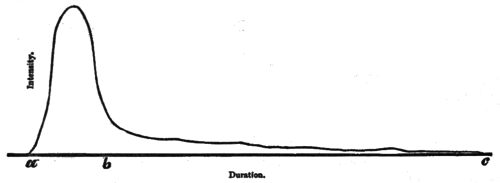than the millionth or the half a millionth of a second, but how much less time it might occupy remained to be determined.
Prof. Rood now prepared for a more rigorous course of experiments. He used a small Leyden jar, with a surface of eleven inches, about equal to a moderate-sized wine-glass. To secure greater exactness of observation, he devised a peculiar micrometer, consisting of five lines ruled on a plate of glass smoked by lamp-black. This plate was placed between l and S (see Fig. 4), but quite near to the latter, and an image of the lines reflected from the mirror was formed on the clear glass at i. The lines were observed by a microscope magnifying ten diameters. In using this micrometer, the measurement was effected by noticing at what rate of the revolving mirror the lines in the image at i were obliterated, this obliteration being due to the circumstance that by the motion of the mirror the dark lines were superposed on the bright lines. The individual spark now produced was about a millionth of a second in duration, but the faint train was still observable. There was still the brilliant body of the spark appearing, first followed by a faint streak of less than one-hundredth the illuminating power of the first stage. The diagram, Fig. 6, represents the intensity
Fig. 6.

and time of the spark. The elevation, or peak, a b, shows the intensity of the first compact body of the spark, and the line a c the duration of the whole effect. The point was to get the time of a b, which Prof. Rood had proved must be regarded as a distinct act in the succession of effects. All precautions for observation being carefully made, the driving-weight was gradually increased, and the speed of the mirror carried up to 350 revolutions per second, when the lines of the image, which at first remained visibly as distinct as with a stationary mirror, became regularly less distinct, and at length vanished by the gradual superposition of the white and black lines. Prof. Rood says: "It was proved successively that the duration was less than eighty, sixty-eight, fifty-nine, fifty-five billionths of a second; and, finally, the lines, after growing fainter and fainter, entirely disappeared, giving as the result a duration of forty-eight billionths of a second." By reducing the striking distance, a still lower figure was
